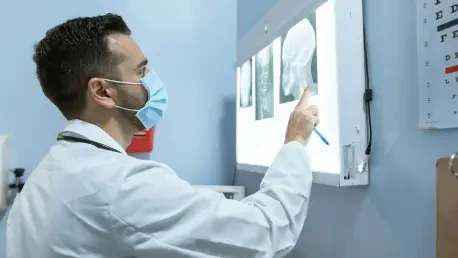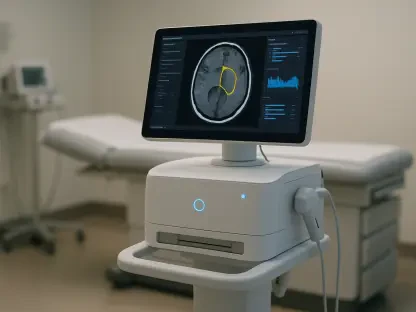The realm of interventional radiology (IR) is emerging as a transformative force in healthcare, seamlessly integrating cutting-edge imaging technologies with minimally invasive procedures to address a spectrum of medical conditions. This specialized field leverages tools like X-rays, ultrasound, computed tomography (CT), and magnetic resonance imaging (MRI) to guide tiny instruments such as catheters and needles, providing alternatives to conventional surgery. Patients experience shorter recovery periods, fewer complications, and often superior results. A recent analysis by Medi-Tech Insights forecasts that the global IR market will expand at a consistent compound annual growth rate (CAGR) of about 6% through 2030, reflecting a robust trajectory fueled by evolving medical needs and innovation. This growth underscores the increasing reliance on IR to tackle pressing health challenges with precision and efficiency, setting the stage for a deeper exploration of the factors driving this dynamic sector.
Forces Shaping Market Expansion
Chronic Disease Burden and Aging Populations
The escalating prevalence of chronic illnesses, coupled with a globally aging demographic, stands as a primary driver for the interventional radiology market. Conditions such as cardiovascular diseases, various forms of cancer, and stroke are becoming more widespread, particularly among older populations where health risks are heightened. IR offers tailored solutions that minimize physical strain on patients, using techniques like angioplasty and embolization to treat complex issues without the invasiveness of traditional surgery. This approach not only addresses the urgent need for effective interventions but also aligns with the growing emphasis on preserving quality of life for those affected by long-term health conditions. As healthcare systems grapple with rising case numbers, the ability of IR to deliver targeted care positions it as an indispensable tool in modern medicine.
Beyond the sheer volume of chronic disease cases, the unique needs of aging populations further amplify the demand for interventional radiology. Older patients often face multiple comorbidities, making them less suitable candidates for open surgeries due to higher risks of complications. IR procedures, such as tumor ablation for cancer treatment, provide safer alternatives that reduce hospital stays and accelerate recovery. Additionally, the focus on early diagnosis and intervention in many healthcare policies globally supports the adoption of IR, as it allows for timely management of conditions like peripheral artery disease before they escalate. This synergy between demographic trends and clinical priorities highlights why the market is poised for sustained growth over the coming years.
Shift to Minimally Invasive Care
A notable trend propelling the IR market forward is the widespread shift toward minimally invasive treatments across healthcare settings. Patients and medical professionals increasingly favor these methods for their ability to lower costs, reduce pain, and shorten recovery times compared to traditional surgical options. Interventional radiology fits squarely into this paradigm, offering procedures that require only small incisions or none at all, thus minimizing trauma to the body. This preference is evident in the growing use of IR for conditions ranging from vascular issues to chronic pain, reflecting a broader movement toward patient-centered care that prioritizes comfort and efficiency.
This shift is also driven by heightened awareness among patients about the benefits of less invasive options, facilitated by advancements in medical education and digital health resources. Hospitals and clinics are responding by integrating IR into their service offerings, recognizing the dual advantage of improved patient satisfaction and operational cost savings. For instance, procedures like vertebroplasty for spinal fractures enable patients to return to daily activities much sooner than with conventional treatments. As this trend gains momentum, it reinforces the market’s growth potential, with IR becoming a cornerstone of modern therapeutic strategies that balance clinical effectiveness with patient well-being.
Innovations and Industry Dynamics
Advances in Imaging and Procedural Tools
Technological progress is revolutionizing interventional radiology, with significant enhancements in imaging systems and procedural equipment driving both precision and safety. Innovations in MRI, CT, and ultrasound technologies have sharpened diagnostic accuracy, enabling radiologists to perform complex interventions with greater confidence. The incorporation of artificial intelligence (AI) into image analysis further refines this process by identifying patterns and anomalies that might be missed by the human eye. Additionally, robotics is beginning to play a role in procedural control, reducing variability and enhancing outcomes. These advancements collectively minimize risks such as radiation exposure for both patients and healthcare providers, marking a new era in IR capabilities.
Equally impactful is the development of tools that support real-time guidance during procedures, ensuring unparalleled accuracy. Augmented reality (AR) systems, for example, overlay critical data onto a surgeon’s field of view, allowing for precise navigation through intricate anatomical structures. Such technologies not only improve the success rates of interventions like stent placements but also expand the feasibility of performing IR in diverse settings, including outpatient facilities. As these cutting-edge solutions become more accessible, they pave the way for broader adoption of IR, addressing complex medical challenges with tools that were once unimaginable, thus fueling market expansion through 2030.
Industry Collaborations and Product Development
Strategic partnerships and innovative product launches are shaping the future of interventional radiology, as industry leaders work to push the boundaries of what is possible. A notable example is the collaboration between GE HealthCare and MediView XR Inc. in June 2024, which resulted in the introduction of the OmnifyXR suite. This platform utilizes holographic imaging to provide unprecedented precision during procedures, setting a new standard for IR applications. Such alliances highlight how companies are pooling expertise to address critical needs in the field, from improving procedural accuracy to enhancing patient safety through reduced radiation exposure.
Beyond specific products, the broader trend of investment in research and development underscores the competitive drive within the IR sector. Major players like Siemens Healthineers and Boston Scientific are consistently rolling out advanced systems and tools designed to tackle emerging clinical demands. These efforts are often complemented by collaborations with academic institutions and technology firms, fostering an ecosystem of innovation. The focus on creating solutions that are both effective and user-friendly for radiologists ensures that new developments translate into tangible benefits at the point of care, reinforcing the market’s growth trajectory with each breakthrough.
Emerging Opportunities and Challenges
Broadening Clinical Applications
Interventional radiology is witnessing a remarkable expansion in its scope, moving beyond traditional domains like cardiology and urology to impact diverse medical fields. Applications in oncology, for instance, have grown significantly, with techniques such as tumor ablation offering non-surgical options for cancer treatment. Similarly, IR is making strides in gastroenterology, gynecology, and pain management, demonstrating its versatility in addressing a wide array of clinical challenges. This broadening of use cases not only diversifies the market but also solidifies IR’s role as a critical component of comprehensive healthcare, capable of adapting to evolving medical needs.
The expansion into new therapeutic areas is further supported by ongoing research that identifies novel applications for IR techniques. For example, the use of embolization in managing chronic conditions like uterine fibroids showcases how IR can provide targeted relief where few alternatives exist. This adaptability attracts investment and interest from healthcare providers seeking innovative ways to improve patient outcomes across specialties. As more medical disciplines recognize the potential of IR, the market benefits from an expanding user base, driving demand for specialized equipment and training, which in turn fuels long-term growth and integration into standard care protocols.
Geographic Growth Opportunities
While North America and Europe currently lead the interventional radiology market due to their advanced healthcare infrastructure and high technology adoption rates, the Asia-Pacific region is emerging as a significant growth frontier. Countries such as China, India, and Japan are experiencing rapid increases in healthcare investments, alongside a rising prevalence of chronic diseases that necessitate advanced interventions. This combination of economic and demographic factors creates a fertile environment for IR expansion, as governments and private sectors prioritize modern medical solutions to address growing health burdens.
Additionally, the increasing awareness of minimally invasive treatment options among patients and providers in the Asia-Pacific region is accelerating market penetration. Local healthcare systems are beginning to adopt IR technologies to meet the demand for efficient, cost-effective care, particularly in densely populated urban centers where access to cutting-edge treatments is a priority. International companies are also entering these markets through partnerships and localized product offerings, recognizing the potential for substantial returns. This geographic shift signals a global rebalancing of the IR landscape, with emerging economies playing a pivotal role in shaping future growth patterns through 2030.
Potential Barriers to Adoption
Despite the promising outlook for interventional radiology, certain challenges could impede its widespread adoption, particularly in less developed regions. The high cost of advanced equipment, such as state-of-the-art imaging systems and robotic tools, poses a significant barrier for healthcare facilities with limited budgets. This financial constraint often limits the ability of smaller hospitals or clinics in emerging markets to integrate IR into their services, potentially widening disparities in access to cutting-edge care and slowing overall market expansion.
Another critical hurdle lies in the specialized training required for radiologists to perform IR procedures effectively. The complexity of these techniques demands extensive education and hands-on experience, which can be difficult to scale in regions with shortages of skilled professionals or inadequate training infrastructure. Addressing this gap necessitates targeted initiatives, such as international training programs or telemedicine-based mentorships, to build capacity. Overcoming these obstacles will be essential to ensure that the benefits of IR reach a broader population, sustaining the market’s projected growth while promoting equitable healthcare advancements globally.









